Optimism Ecosystem Review
Key Insights
- Optimism enhances Ethereum's scalability and efficiency by utilizing Optimistic Rollups, which aggregate multiple transactions into a single block to reduce network load and transaction fees.
- Optimism ecosystem ensures full compatibility with the Ethereum Virtual Machine, allowing seamless migration of existing Ethereum apps, and maintains high security through a decentralized, tamper-resistant architecture.
- Optimism layer 2 supports a robust ecosystem for dApps, with significant integration of popular DeFi protocols like AAVE, Synthetix, and Uniswap, offering users lower fees and faster transactions
Optimism ecosystem is a Layer 2 scaling solution for the Ethereum network that utilizes Optimistic Rollups technology. It aims to increase throughput and reduce transaction costs on the Ethereum network.

Optimism aggregates numerous transactions into a single block, which is then sent to the Ethereum mainnet, significantly reducing network load and lowering fees. As one of the leading Ethereum scaling solutions, Optimism enhances the network's efficiency and user experience.
Main Objectives of the Optimism Ecosystem
- Scalability
To enhance Ethereum's throughput, enabling the network to process thousands of transactions per second compared to the current capacity of dozens of transactions per second. As one of the leading Ethereum scaling solutions, Optimism uses Optimistic rollups to achieve this increased scalability.
- Reducing Fees
To significantly lower transaction costs. High gas fees on the Ethereum mainnet make many operations costly, limiting their use. Optimism aims to make transactions more accessible to all users.
- Compatibility
To facilitate the seamless transition of existing Ethereum applications and protocols to the Optimism platform. This is achieved through full compatibility with the Ethereum Virtual Machine (EVM), allowing developers to migrate their projects without significant code changes.
- Security
To maintain a high level of security by using a decentralized and tamper-resistant architecture. Optimism inherits the security of the Ethereum mainnet and is further protected by verification mechanisms and fraud proofs.
- Support for dApps
To create a favorable ecosystem for the development and use of decentralized applications. Optimism ecosystem actively works on integrating popular DeFi protocols and other dApps to provide users with a comprehensive range of functionalities available on the Ethereum mainnet, but with greater efficiency.
Optimism Project Foundation
When and by whom was the project created? Optimism was founded in 2019 by a team of engineers and developers aiming to solve the scalability and high transaction cost issues on the Ethereum network. The mainnet officially launched in December 2021 after several months of testing and optimization on the testnet.
Optimism Key Development Team
The Optimism team consists of highly qualified professionals with extensive experience in blockchain technology, cryptography and software development. Here are some of the key figures of the project.
- Jinglan Wang
Jinglan Wang is the co-founder and CEO. Previously worked at the Ethereum Foundation, focusing on developing scalable blockchain solutions. Her expertise in project development and strategic management in the crypto industry played a crucial role in the establishment of Optimism.
- Kevin Ho
Kevin Ho is the co-founder and CTO. With extensive experience in software development and cryptographic protocol research, he previously worked at Plasma Group, where he researched and developed blockchain scaling technologies.
- Karl Floersch
Karl Floersch is the Chief Researcher. Formerly at the Ethereum Foundation, Karl worked on various scaling solutions, including Plasma and other approaches. His deep knowledge of cryptography and decentralized systems contributed to the innovative technologies underlying Optimism.
- Ben Jones
Ben Jones is the Chief Scientist. Holding a Ph.D. in computer science, Ben has extensive research experience. He joined Optimism to lead scientific research and ensure academic rigor in the project’s technological development.
Technology: Optimistic Rollups
Optimistic Rollups is an advanced Layer 2 technology for scaling the Ethereum blockchain.
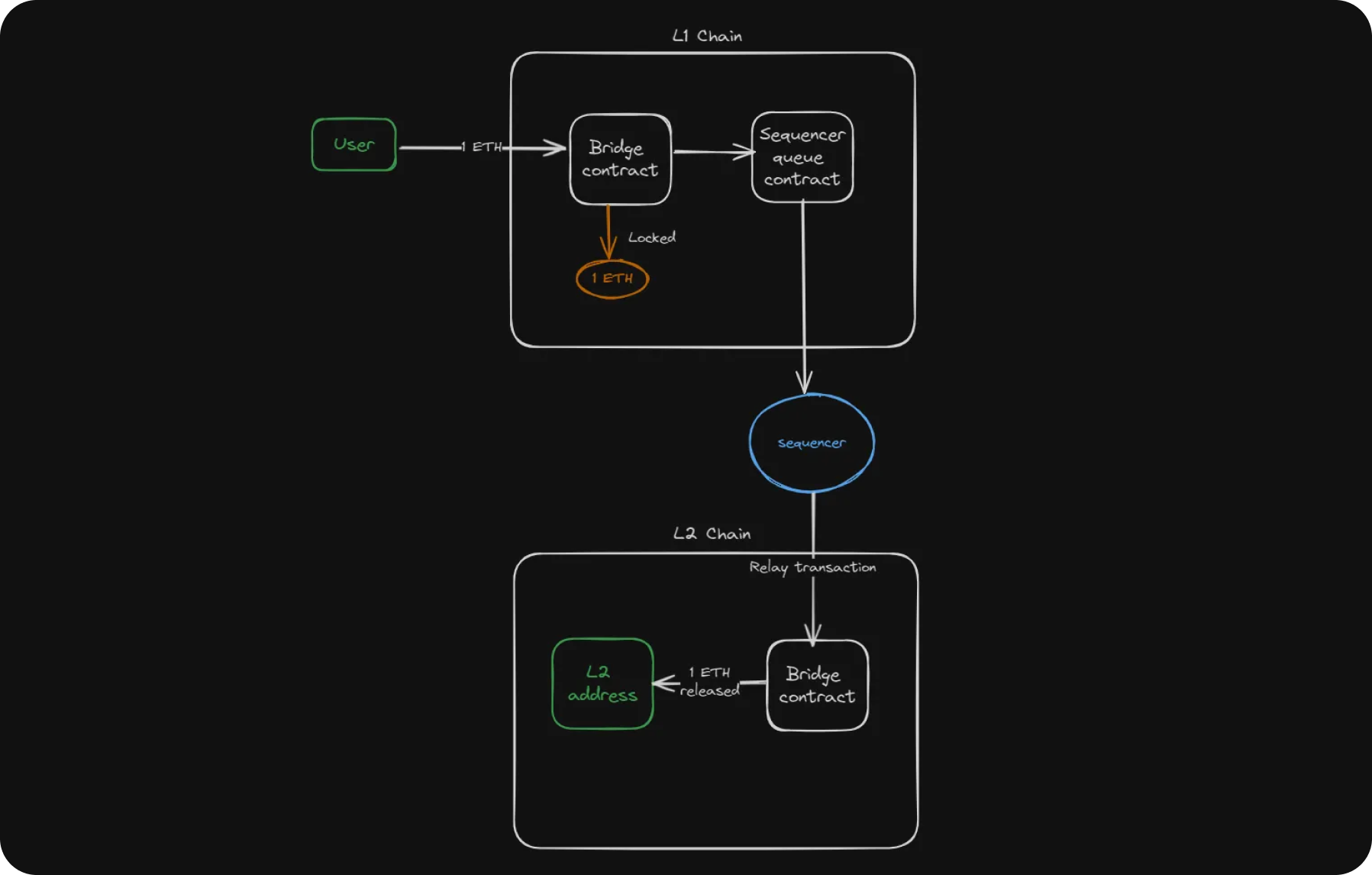
It is designed to significantly increase network throughput and reduce transaction fees, while maintaining a high level of blockchain security and decentralization. Let's take a closer look at the basic principles and components of this innovative technology.
Principles of Operation
- Transaction Aggregation
Optimistic Rollups combine multiple small transactions into a large block of data called a "rollup." This rollup block contains the transactions and the current system state, allowing verifiers to check transaction correctness using state roots.
- Data Publication
Transaction data is published on the Ethereum mainnet, but actual transaction processing and execution occur off-chain, reducing network load and accelerating transaction confirmation while lowering fees.
- Optimistic Assumption
Optimistic Rollups operate on the assumption that most transactions in the rollup are correct. However, if a transaction is incorrect, any network participant can challenge it during the challenge period. If successfully challenged, the transaction is invalidated, and the system reverts to the correct state.
- Challenge Period
The challenge period is a timeframe during which participants can contest a transaction. This ensures transaction validity and network protection against attacks.
- Sequencer and Verifiers
The Sequencer is a specialized temporary node that orders transactions and generates rollup blocks. Verifiers check the correctness of transactions in these blocks, using state data and other parameters to ensure the operations’ accuracy.
Optimism System Components
- Rollup Node
Collects and aggregates transactions into rollup blocks, then publishes them on the Ethereum mainnet. This is a key component in the implementation of Optimistic rollups, which are crucial for enhancing the scalability of Ethereum.
- Sequencer
A specialized node that temporarily manages the rollup block generation process, ordering them for subsequent verification and confirmation by verifiers. The role of the Sequencer is vital in the Optimism ecosystem to ensure efficient and orderly transaction processing.
- Verifiers
Network nodes that verify transaction correctness in rollup blocks. They actively participate in the challenge process and can provide proof to maintain system integrity. The verifier’s role is integral to the security mechanism within Optimism layer 2 solutions.
Ethereum Smart Contracts
- Rollup Contract
A smart contract on the Ethereum mainnet that manages the rollup and transaction challenge process. This contract ensures the security and transparency of rollup interactions.
- Fraud Proof Contract
Processes initiated fraud proofs. If fraud is confirmed, this contract invalidates incorrect transactions and penalizes the offending participants. This contract is essential for maintaining trust and integrity within the Optimism ecosystem.
Rollup Data
- Batch Submissions
Submitted rollup transactions on the Ethereum mainnet contain compressed information about multiple operations, reducing network load and speeding up transaction processing. This efficiency is a significant advantage over other Ethereum scaling solutions.
- State Roots
Published with rollup data, state roots allow verifiers and other network participants to check the network’s current state and ensure data integrity.
Transaction Challenges
- Challenge Period
A specified timeframe during which participants can challenge a transaction or provide proof of its incorrectness. This ensures transaction validity and network protection against potential attacks.
These components collectively make Optimistic Rollups not only a powerful tool for scaling Ethereum but also an efficient mechanism for creating decentralized applications and services while maintaining blockchain technology’s security and reliability principles.
Optimism Layer 2: Comparison with Other Layer 2 Solutions
Competitors of Optimistic Rollups in the Layer 2 solutions space for Ethereum include projects such as Arbitrum and zkSync. When comparing Optimism vs Arbitrum and Optimism vs zkSync, each has unique features and advantages depending on specific needs. Let's look at a brief overview of each.
Arbitrum Features
- Technology
Based on rollups technology, allowing transactions to be compressed into rollup blocks and sent to the Ethereum chain for confirmation.
- Transaction Speed
High transaction confirmation speed due to rollup technology and optimizations aimed at speeding up the process. In the debate of Optimism vs Arbitrum, transaction speed is a crucial factor that differentiates these two platforms.
- Ethereum Compatibility
Developed with a focus on compatibility with the Ethereum infrastructure, making integration and transition from the mainnet easier.
- Enhanced UX
Minimizes transaction confirmation wait times and improves user experience through a shorter challenge period. This enhancement is particularly notable when comparing Arbitrum vs Optimism, as both aim to provide seamless user experiences but with different approaches and optimizations.
zkSync Features
- zk-rollups Technology
Uses zk-rollups technology, ensuring a high level of privacy and security thanks to zkSNARKs.
- High Speed and Low Fees
Zk-rollups enable zkSync to achieve high transaction execution speed and low fees, making it competitive among Layer 2 solutions.
- Data Privacy
Ensures data privacy through zkSNARKs, which can be an important factor for some users.
Optimism Competitive Environment Analysis
Each of these solutions has unique features and advantages that can be significant depending on developers' and users' specific needs:
- Optimistic Rollups
Ensures simplicity of development and high decentralization, supporting a lower level of complexity when integrating with Ethereum.
- Arbitrum vs Optimism
Offers high speed and enhanced UX through transaction confirmation process optimizations.
- zkSync vs Optimism
Stands out with a high level of data privacy and security due to zkSNARKs, important for users valuing confidentiality.
OP Cryptocurrency
The Optimism project has its own cryptocurrency, OP. Since its launch in 2022, the team plans to release a total of 4.29 billion tokens. OP tokens are needed for users to participate in voting and other project activities.
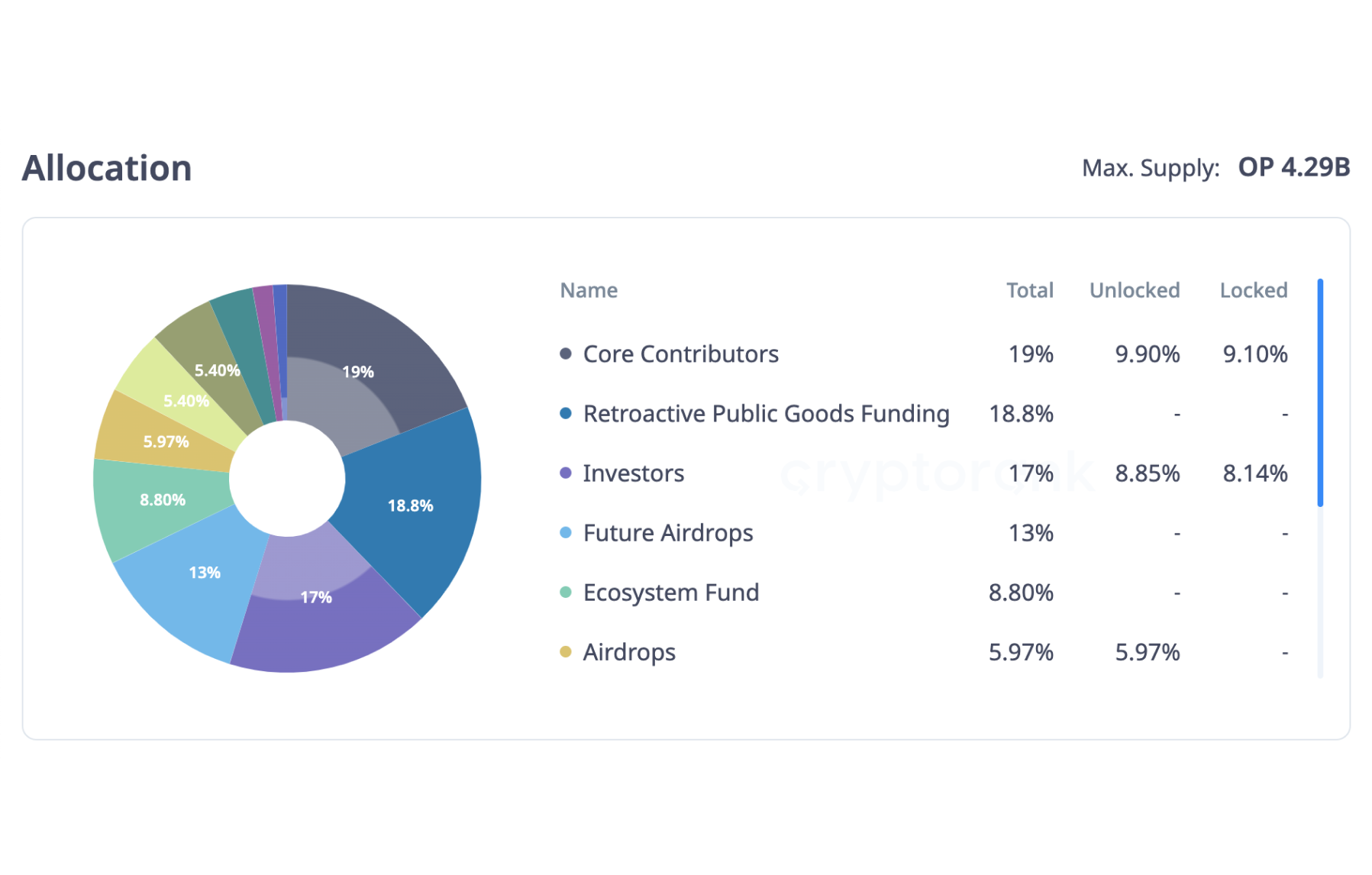
The first token distribution phase took place in the form of an airdrop, completed on June 1, 2022. At that time, tokens were distributed among 232,000 users, receiving a total of 231,928,234 OP, accounting for 5.4% of the total planned token supply. The team plans to distribute a total share of 19% of the total OP supply through airdrops.
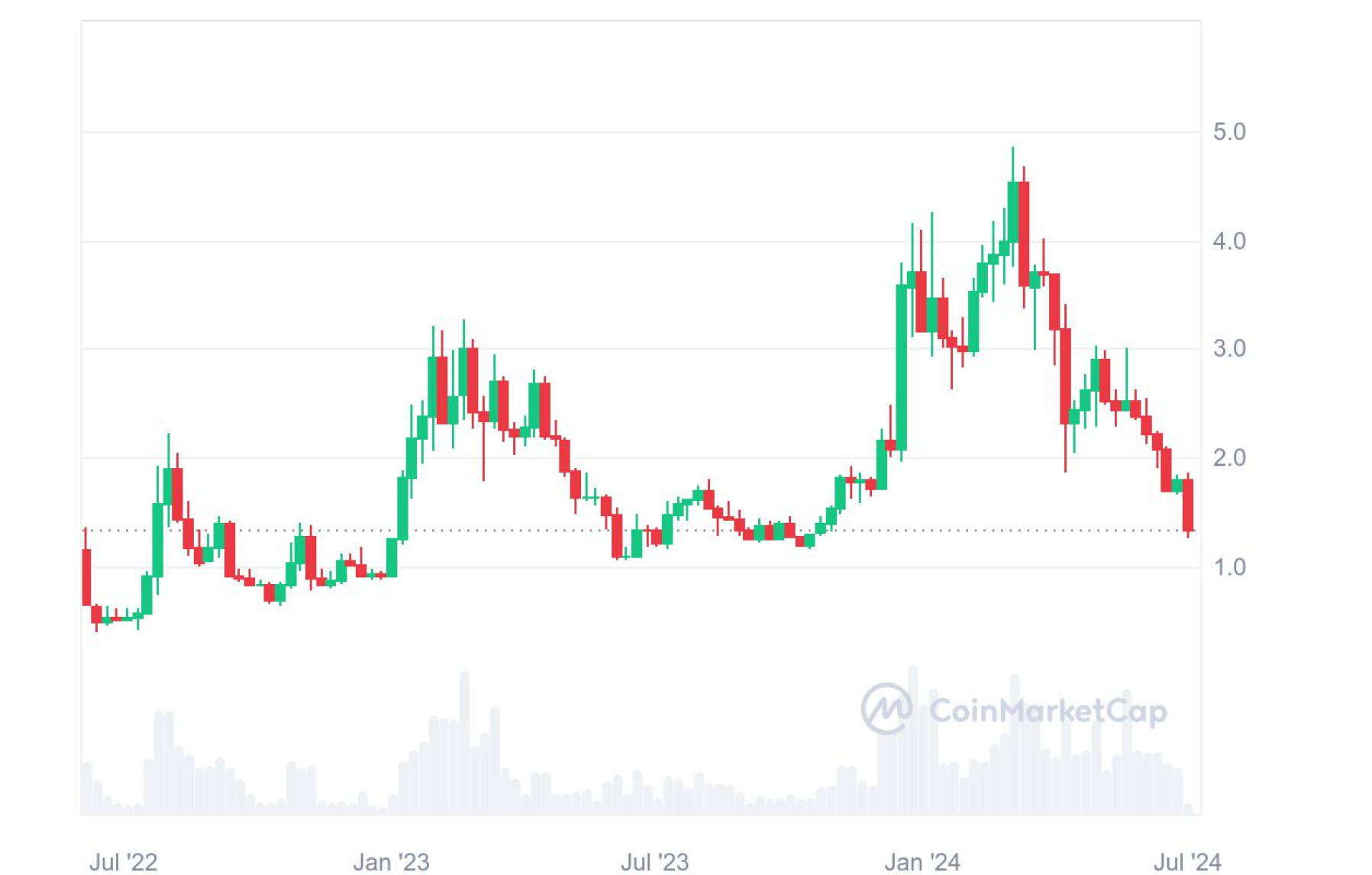
Users can get OP cryptocurrency on SimpleSwap.
In the Optimism ecosystem, OP tokens have several key purposes and goals:
- Transaction Fees
OP tokens can be used to pay transaction fees on the Optimism network. While main transactions on Optimism are paid in ETH, OP tokens can be used to pay for other services within the platform or specific transactions.
- Governance Participation
OP token holders can use them to participate in Optimism governance and decision-making within the Optimism ecosystem. This can include participation in protocol changes, improvement proposals, and other forms of voting affecting platform development.
DeFi Apps on Optimism
Optimism processes thousands of transactions per second, significantly exceeding the mainnet Ethereum’s throughput. This makes DeFi applications on Optimism ecosystem more responsive and user-friendly, minimizing delays and improving the overall user experience.
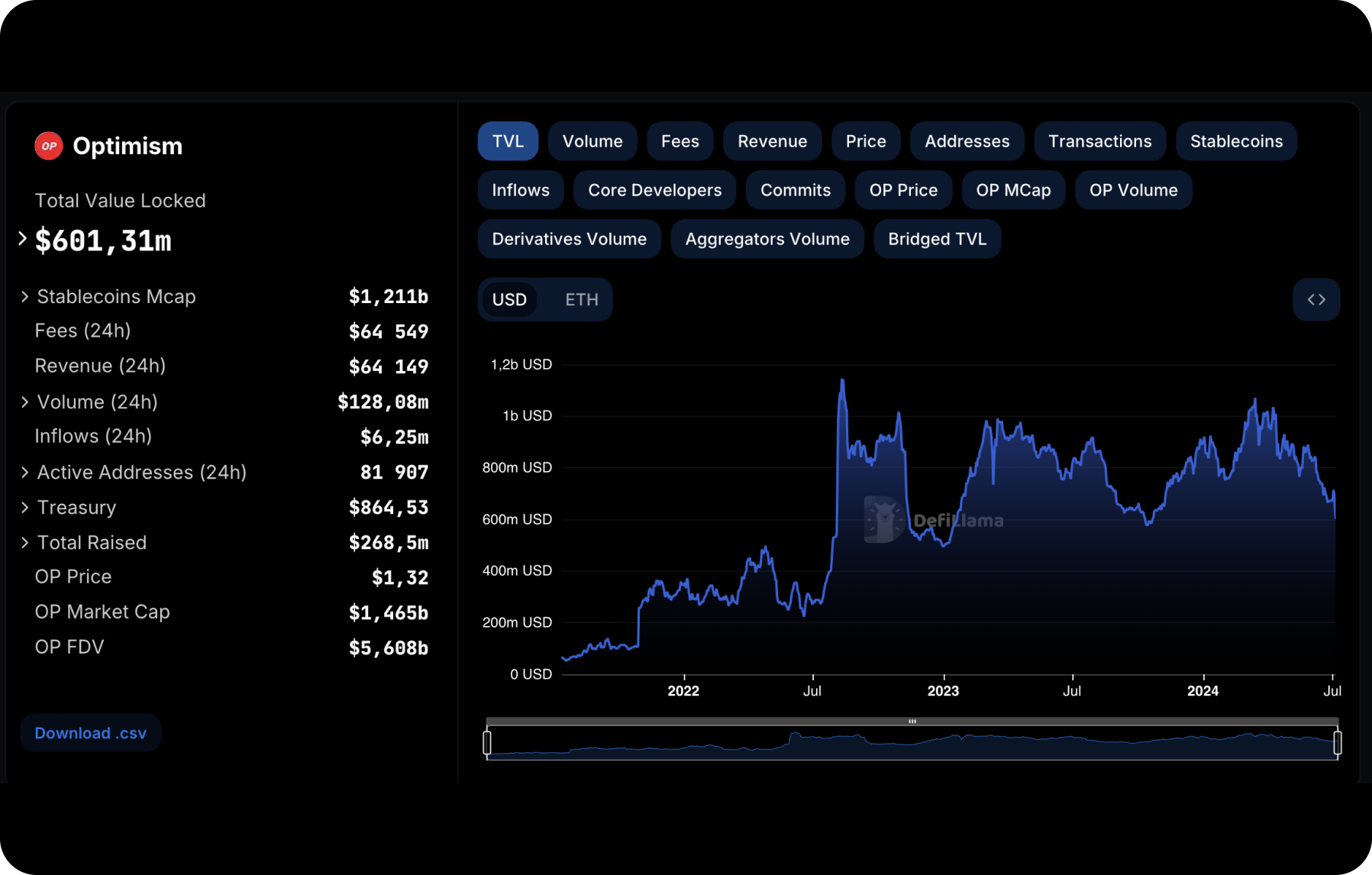
Transactions on the Optimism network have significantly lower fees compared to the Ethereum mainnet, reducing transaction execution costs in DeFi applications and making them more accessible to a broader user base.
Top DeFi Protocols on Optimism
Below are some of the most well-known DeFi protocols on Optimism.
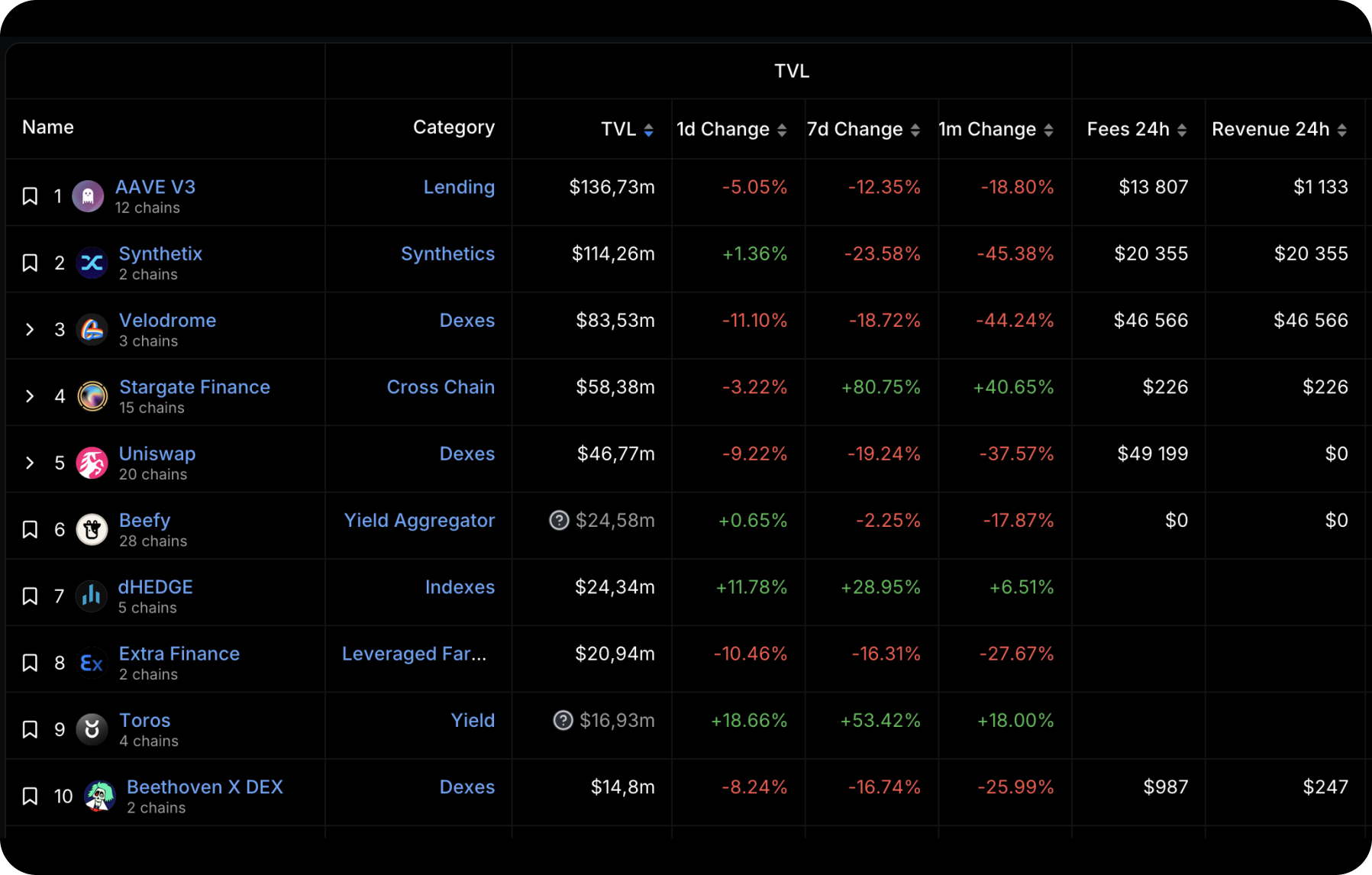
- TVL (Total Value Locked): $137 million
- AAVE is a leading DeFi protocol on the Optimism platform. It allows users to borrow and lend digital assets. Low fees and high transaction speeds make using AAVE on Optimism particularly attractive to users.
Synthetix
- TVL (Total Value Locked): $115.79 million
- Synthetix leverages Optimism's capabilities to issue synthetic assets, enabling users to trade various derivatives with high efficiency. The low fees and high transaction speeds provided by Optimism ensure a more convenient and accessible experience for traders and investors.
Velodrome
- TVL (Total Value Locked): $84.25 million
- Velodrome crypto is a decentralized exchange and liquidity provisioning platform operating on Optimism. It offers competitive fees and high transaction speeds, making it attractive for traders and liquidity providers.
Stargate Finance
- TVL (Total Value Locked): $58.53 million
- Stargate Finance is a cross-chain liquidity protocol that allows users to move assets between different blockchains. Integration with Optimism ecosystem enables Stargate Finance to offer high speed and low fees for cross-chain transactions.
- TVL (Total Value Locked): $46.78 million
- Uniswap, one of the most popular decentralized exchanges, is integrated with Optimism, allowing users to trade assets with minimal delays and low fees.
Summary
Optimism is a cutting-edge Layer 2 scaling solution for the Ethereum network, using Optimistic Rollups technology. The primary goals of the project include increasing throughput, reducing transaction fees, ensuring compatibility with existing Ethereum applications, and maintaining a high level of security. Optimism Layer 2 employs Optimistic Rollups to allow the aggregation of multiple transactions into a single block, significantly reducing the load on the Ethereum mainnet and lowering transaction costs.
The Optimism team, comprising experienced blockchain and cryptography specialists, has developed an efficient system with key components such as Rollup Nodes, Sequencers, and Verifiers, as well as smart contracts on the Ethereum mainnet. These components work together to ensure high performance and network security.
Comparing Optimism with competitors such as Arbitrum and zkSync reveals that each Layer 2 solution has unique advantages. Optimism stands out for its simplicity of development and decentralization, while Arbitrum and zkSync offer features like improved user experience and high data privacy, respectively.
Optimism also uses its own cryptocurrency, OP, essential for project governance. DeFi applications on the Optimism platform, such as AAVE, Synthetix, Velodrome, Stargate Finance, and Uniswap, demonstrate high performance and low fees, making them attractive to users.
Optimism ecosystem continues to develop actively, integrating new protocols and applications, making it a significant player in the Ethereum ecosystem and contributing to a more scalable and accessible blockchain network.
The information in this article is not a piece of financial advice or any other advice of any kind. The reader should be aware of the risks involved in trading cryptocurrencies and make their own informed decisions. SimpleSwap is not responsible for any losses incurred due to such risks. For details, please see our Terms of Service.


